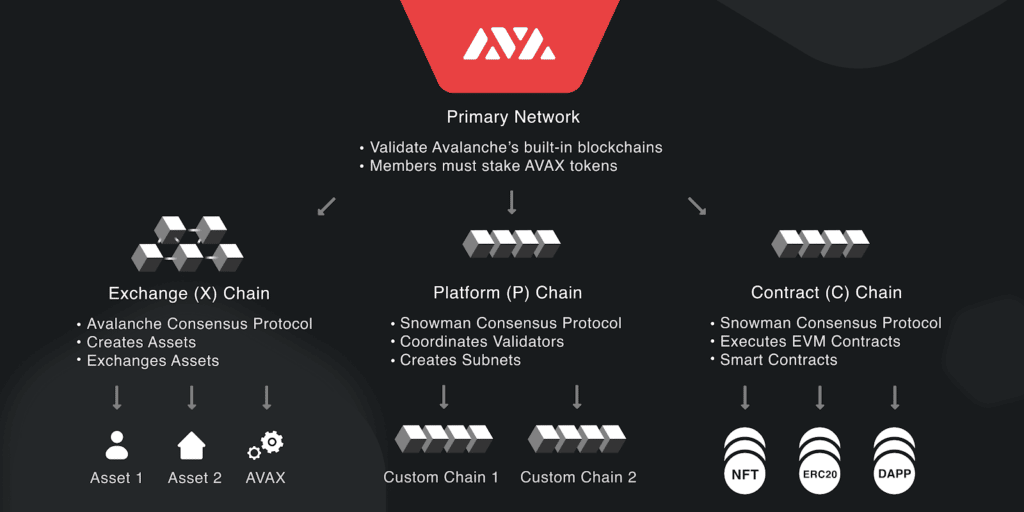The Avalanche crypto ecosystem allows the creation of subnets: let’s see what a subnet is and how it works.
Avalanche subnets are sovereign networks with their own rules, composed of a dynamic subset of Avalanche validators.
Each subnet can have many blockchains, but each individual blockchain is validated only by a single subnet. A validator in turn can be a member of several subnets, but all subnet validators must also validate the primary Avalanche network.
Subnets were introduced to be able to be independent, that is, with their own execution logic that does not depend on the primary network. In fact, they can independently determine their own pricing scheme, maintain their own state, facilitate their own network and provide their own level of security. They also do not share the execution thread and transactions with other subnets or the primary network, thus enabling easy scalability, with lower latency, higher TPS and lower transaction costs.
In other words, Avalanche’s subnets act independently of the Avalanche network itself, so that they do not interfere with it and, conversely, have no interference from the primary network or other subnets. Of course, they do need their own validator nodes to operate, partly because validators on the main network generally do not also work on subnets.
Summary
Tokens
In this way, subnets can have their own token economy independent of that of Avalanche, with their own native tokens. They can even launch new blockchains with customized virtual machines.
Since anyone can create an Avalanche subnet, they can also create their own autonomous and particular token economy in this way, with tokens that may not even exist on the main Avalanche blockchain.
What is a subnet in the crypto world and what role do validators play
The policy on validators can also be customized.
In fact, among its own unique rules, a subnet can have the requirement that validators must be located in a certain country, or that they must pass KYC/AML checks, or that they must hold a certain license.
This makes it possible to build a kind of permissioned blockchain based on a permissionless and trustless ecosystem.
This can be useful for blockchain-based applications that require validators to have certain properties, such as an application that requires large amounts of RAM or computing power: a subnet in this case can require validators to meet certain hardware requirements so that the application does not have reduced performance.
What is a subnet and how it interacts with virtual machines and the creation of crypto alternatives
Subnets have virtual machines (VMs) that define the blockchain logic at the application level, specifying the blockchain state, state transition function, transactions, and APIs with which users can interact with the blockchain. Effectively on Avalanche, each blockchain is an instance of a VM.
The advantage is that it is possible to create VMs without having to worry about developing the lower-level logic, such as networking, consensus and blockchain structure, because that is done by the upstream Avalanche ecosystem.
VMs should be considered as projects for individual blockchains, such that one can even use the same VM to create many blockchains with the same set of rules, but logically independent.
The reason VMs were introduced is that usually classic blockchains have only one, with an inevitably predefined and static feature set. Thus those who wanted to create custom decentralized applications with their own rules were forced to create a new blockchain network from scratch.
Ethereum has partially solved this problem with smart contracts, although they depend on a single VM that inevitably imposes restrictions on developers.
Conversely, with Avalanche’s VMs, it is easier to create decentralized blockchains and applications with completely new rules that do not have to depend on external blockchains.
The primary network
Avalanche’s primary network itself was created with three subnets: Exchange Chain (X-Chain), Platform Chain (P-Chain) and Contract Chain (C-Chain).

The primary network is also a subnet, though a special one, because all members of all subnets must also be members of the primary network, and they must be staking at least 2,000 AVAX.
The primary network operates completely independently of all other subnets, so that they cannot interfere with its proper operation. The only restriction is precisely that the validators of the subnets must also be validators of the mainnet.
It is worth noting that the number of transactions recorded daily on Avalanche’s C-Chain increased greatly during 2022.
Avalanche is a relatively recent project, born in 2020, so the first complete data is only from 2021.
Until mid-August last year, that is, at the height of bull run, there were rarely more than 15,000 transactions per day. But then they suddenly soared, so that by the end of August they had risen to as many as 230,000.
The real boom came from October 2021, with a peak of 1.1 million daily transactions at the end of January 2022.
In May, due to the implosion of the Terra/Luna ecosystem, they plummeted to 250,000, then dropped again to the current 110,000. However, this figure is still almost ten times higher than in July last year.
This means that although the bubble has deflated since May, the use of Avalanche’s Contract Chain is still very high compared to previous years.
The crypto AVAX
By contrast, the price trend of Avalanche’s native cryptocurrency, namely AVAX, has followed a very similar trend to that of other cryptocurrencies.
Ignoring 2020, i.e., the launch year, by January 2021 the price had already risen to $12, with an impressive first spike to $55 the following month.
After a sharp retracement, a large speculative bubble began to inflate in August of that year, leading up to an all-time high of $145 in November.
Then the bubble burst, with the price falling to $57 in early May this year.
The real crash came during the implosion of the Terra/Luna ecosystem, in some ways similar to Avalanche, with the price plummeting to $15 in June and dropping out of the top 10 cryptocurrencies with the largest market capitalization.
Since then, a long phase of downward lateralization has been triggered, leading to new annual lows on 20 December at $11.2. The current price is -92% from the highs, and is in line with that of January 2021.




